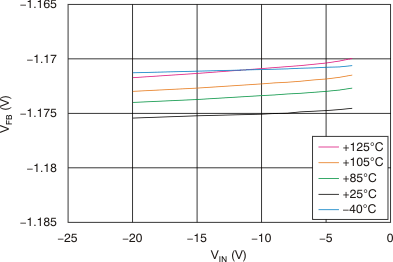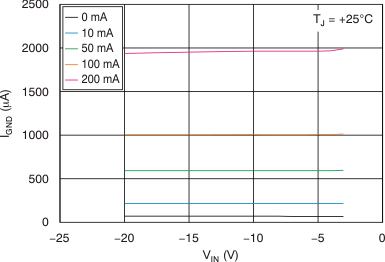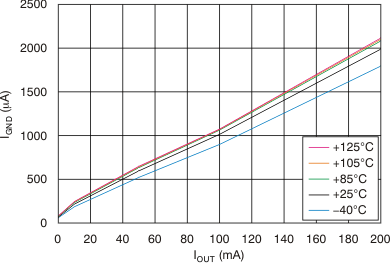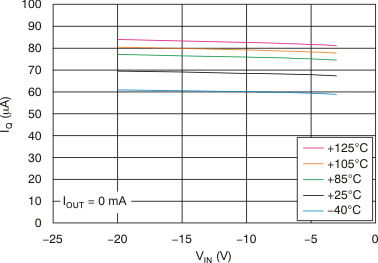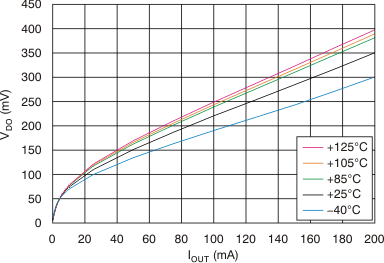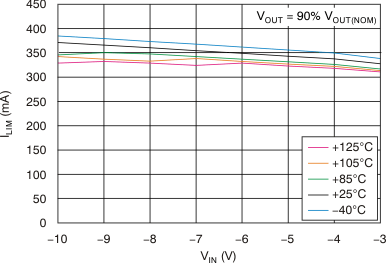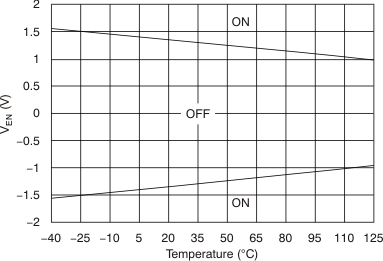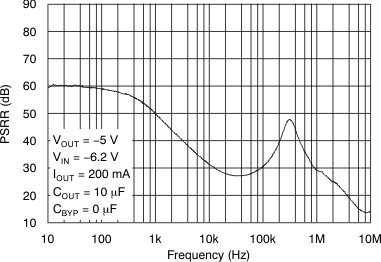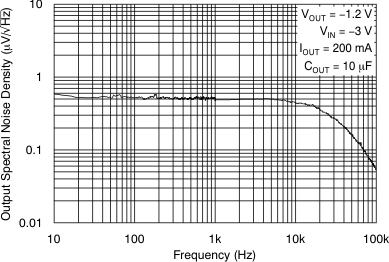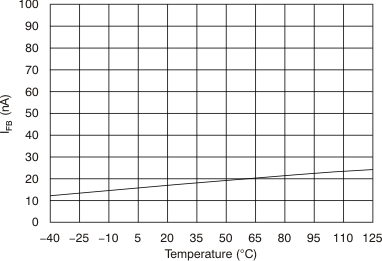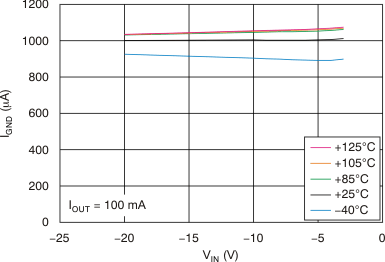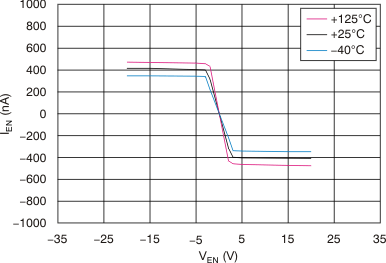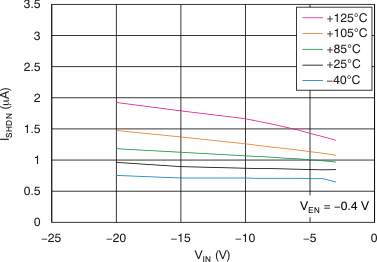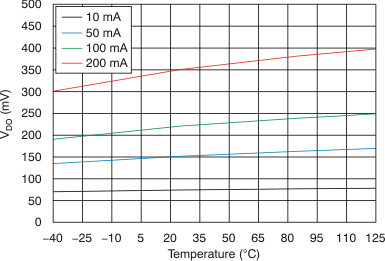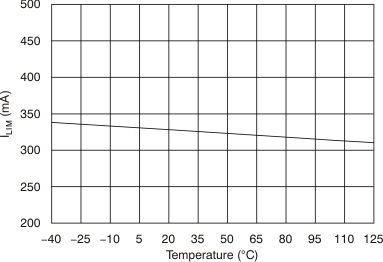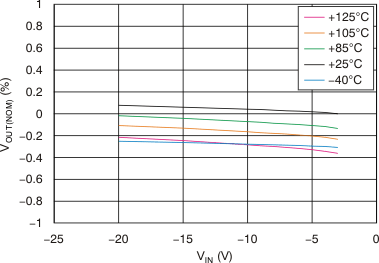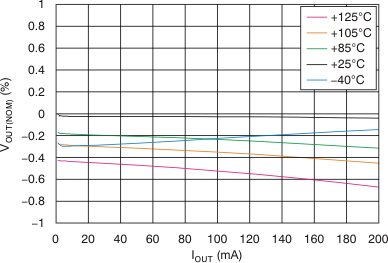SBVS163A June 2011 – May 2015 TPS7A3401
PRODUCTION DATA.
- 1 Features
- 2 Applications
- 3 Description
- 4 Revision History
- 5 Pin Configuration and Functions
- 6 Specifications
- 7 Detailed Description
- 8 Application and Implementation
- 9 Power Supply Recommendations
- 10Layout
- 11Device and Documentation Support
- 12Mechanical, Packaging, and Orderable Information
6 Specifications
6.1 Absolute Maximum Ratings
over operating free-air temperature range (unless otherwise noted).(1)| MIN | MAX | UNIT | ||
|---|---|---|---|---|
| Voltage | IN pin to GND pin | –22 | 0.3 | V |
| OUT pin to GND pin | –22 | 0.3 | ||
| OUT pin to IN pin | –0.3 | 22 | ||
| FB pin to GND pin | –2 | 0.3 | ||
| FB pin to IN pin | –0.3 | 22 | ||
| EN pin to IN pin | –0.3 | 22 | ||
| EN pin to GND pin | –22 | 22 | ||
| NR/SS pin to IN pin | –0.3 | 22 | ||
| NR/SS pin to GND pin | –2 | 0.3 | ||
| Current | Peak output | Internally limited | ||
| Temperature | Operating virtual junction, TJ | –40 | 125 | °C |
| Storage, Tstg | –65 | 150 | ||
(1) Stresses beyond those listed under Absolute Maximum Ratings may cause permanent damage to the device. These are stress ratings only, and functional operation of the device at these or any other conditions beyond those indicated is not implied. Exposure to absolute-maximum rated conditions for extended periods may affect device reliability.
6.2 ESD Ratings
| VALUE | UNIT | ||||
|---|---|---|---|---|---|
| V(ESD) | Electrostatic discharge | Human body model (HBM), per ANSI/ESDA/JEDEC JS-001, all pins(1) | ±1500 | V | |
| Charged device model (CDM), per JEDEC specification JESD22-C101, all pins(2) | ±500 | ||||
(1) JEDEC document JEP155 states that 500-V HBM allows safe manufacturing with a standard ESD control process.
(2) JEDEC document JEP157 states that 250-V CDM allows safe manufacturing with a standard ESD control process.
6.3 Recommended Operating Conditions
over operating free-air temperature range (unless otherwise noted).| MIN | NOM | MAX | UNIT | ||
|---|---|---|---|---|---|
| VIN | Input supply voltage | –20 | –3 | V | |
| VEN | Enable supply voltage | 0 | VIN | V | |
| VOUT | Output voltage | VREF | –18 | V | |
| IOUT | Output current | 0 | 200 | mA | |
| TJ | Operating junction temperature | –40 | 125 | °C | |
| CIN | Input capacitor | 2.2 | 10 | µF | |
| COUT | Output capacitor | 2.2 | 10 | µF | |
| CFF | Feed-forward capacitor | 0 | 10 | nF | |
| R2 | Lower feedback resistor | 237 | kΩ | ||
6.4 Thermal Information
| THERMAL METRIC(1) | TPS7A3401 | UNIT | |
|---|---|---|---|
| DGN (HVSSOP) | |||
| 8 PINS | |||
| RθJA | Junction-to-ambient thermal resistance | 63.4 | °C/W |
| RθJC(top) | Junction-to-case(top) thermal resistance | 53 | °C/W |
| RθJB | Junction-to-board thermal resistance | 37.4 | °C/W |
| ψJT | Junction-to-top characterization parameter | 3.7 | °C/W |
| ψJB | Junction-to-board characterization parameter | 37.1 | °C/W |
| RθJC(bot) | Junction-to-case(bottom) thermal resistance | 13.5 | °C/W |
(1) For more information about traditional and new thermal metrics, see the Semiconductor and IC Package Thermal Metrics application report, SPRA953.
6.5 Electrical Characteristics
At TJ = –40°C to 125°C, |VIN| = |VOUT(nom)| + 1 V or |VIN| = 3 V (whichever is greater), VEN = VIN, IOUT = 1 mA, CIN = 2.2 µF, COUT = 2.2 µF, and the FB pin tied to OUT, unless otherwise noted.(1)| PARAMETER | TEST CONDITIONS | MIN | TYP | MAX | UNIT | |||
|---|---|---|---|---|---|---|---|---|
| VIN | Input voltage | –20 | –3 | V | ||||
| VREF | Internal reference | TJ = 25°C, VFB = VREF | –1.202 | –1.184 | –1.166 | V | ||
| VOUT | Output voltage(2) | |VIN| ≥ |VOUT(nom)| + 1 V | –18 | VREF | V | |||
| Nominal accuracy | TJ = 25°C, |VIN| = |VOUT(nom)| + 0.5 V | –1.5 | 1.5 | %VOUT | ||||
| Overall accuracy | |VOUT(nom)| + 1 V ≤ |VIN| ≤ 20 V 1 mA ≤ IOUT ≤ 200 mA |
–2.5 | 2.5 | %VOUT | ||||
 |
Line regulation | TJ = 25°C, |VOUT(nom)| + 1 V ≤ |VIN| ≤ 20 V | 0.14 | %VOUT | ||||
 |
Load regulation | TJ = 25°C, 1 mA ≤ IOUT ≤ 200 mA | 0.04 | %VOUT | ||||
| |VDO| | Dropout voltage | VIN = 95% VOUT(nom), IOUT = 100 mA | 216 | mV | ||||
| VIN = 95% VOUT(nom), IOUT = 200 mA | 500 | 800 | mV | |||||
| ICL | Current limit | VOUT = 90% VOUT(nom) | 200 | 330 | 500 | mA | ||
| IGND | Ground current | IOUT = 0 mA | 55 | 100 | μA | |||
| IOUT = 100 mA | 950 | μA | ||||||
| |ISHDN| | Shutdown supply current | VEN = 0.4 V | 1 | 5 | μA | |||
| VEN = –0.4 V | 1 | 5 | μA | |||||
| IFB | Feedback current(3) | 14 | 100 | nA | ||||
| |IEN| | Enable current | VEN = |VIN| = |VOUT(nom)| + 1 V | 0.48 | 1 | μA | |||
| VIN = VEN = –20 V | 0.51 | 1 | μA | |||||
| VIN = –20 V, VEN = 15 V | 0.50 | 1 | μA | |||||
| VEN(+HI) | Positive enable high-level voltage | TJ = –40°C to 125°C | 2 | 15 | V | |||
| TJ = –40°C to 85°C | 1.8 | 15 | ||||||
| VEN(+LO) | Positive enable low-level voltage | 0 | 0.4 | V | ||||
| VEN(–HI) | Negative enable high-level voltage | VIN | –2 | V | ||||
| VEN(–LO) | Negative enable low-level voltage | –0.4 | 0 | V | ||||
| Vn | Output noise voltage | VIN = –3 V, VOUT(nom) = VREF, COUT = 10 μF, BW = 10 Hz to 100 kHz | 80 | μVRMS | ||||
| PSRR | Power-supply rejection ratio | VIN = –6.2 V, VOUT(nom) = –5 V, COUT = 10 μF, f = 1 kHz |
50 | dB | ||||
| TSD | Thermal shutdown temperature | Shutdown, temperature increasing | 170 | °C | ||||
| Reset, temperature decreasing | 150 | |||||||
| TJ | Operating junction temperature | –40 | 125 | °C | ||||
(1) At operating conditions, VIN ≤ 0 V, VOUT(nom) ≤ VREF ≤ 0 V. At regulation, VIN ≤ VOUT(nom) – |VDO|. IOUT > 0 flows from OUT to IN.
(2) To ensure stability at no load conditions, a current from the feedback resistive network equal to or greater than 5 μA is required.
(3) IFB > 0 flows into the device.
6.6 Typical Characteristics
At TJ = –40°C to 125°C, |VIN| = |VOUT(nom)| + 1 V or |VIN| = 3 V (whichever is greater), VEN = VIN, IOUT = 1 mA, CIN = 2.2 μF, COUT = 2.2 μF, and the FB pin tied to OUT, unless otherwise noted.